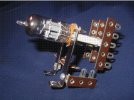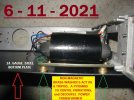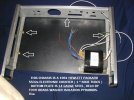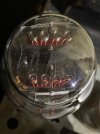Older, more experienced audiophiles I know tended to appreciate the Paragon 10, 12 / 12A, and E 12AX7 phono stages of the late 1970s. Trevor Lees made a similar circuit he cleverly adapted to a DYNA PAS 2 chassis. All of these Phono Preamplifiers used 12AX7s in a wide-band, high-gain cascode circuit arrangement. All of these models sounded good back then, and perform reasonably well in 2021.
I inserted a borrowed late-1970s Trevor Lees preamp into my reference ALTEC VOTT A7-8 horn system, only about two months ago, and certain aspects of its presentation blew me away - such as to it's uncanny sense of " aliveness " on a baritone voice, etc..
Reviewing the RIAA stage's schematic and parts employed, I just felt I had to build my own ( hopefully improved ) version of this same circuit, using modern upgraded parts and power supply techniques I know of in 2021, just to HEAR that result .
That is what this thread is all about.
Pictured below is the " hardware " design / spacial relationship I just worked out this weekend, so as to be able to have short point-to-point wiring, and have a terminal to connect each part. It enables parts installation of the entire RIAA network and a very unique, custom power supply.
What is pictured individually feeds both triodes of a dual triode 12AX7 tube. Each triode will have it's own B+, double series SHUNTED ( to lower impedances ) and it will also individually employ two series L/C " Final Filter " B+ networks - ( a hash choke, film cap, a second hash choke, and film caps, plural ).
Imagine - a brute-force / passive quadruple filtered B+.
It in effect, the unique power supply arrangement separates each triode's B+ feed, from all the others. With this power supply arrangement, a film B+ capacitance supply is positioned within 1/4 of an inch ( or less ) of it's actual use-point, ..... intimate with each tube's Plate Resistor.
I will continue to post design details and build photos. I expect this build to take about three months.
Please note, most of the hardware parts ( shown below ) are manufactured in the USA by Keystone Electronics, and are readily available - such as their "board brackets ", 817 terminal strips, and hex spacers, ....... both in metal and white nylon.
Thank you for looking. These below - are multiple views of just one mechanism. This should be a fun and very rewarding DIY project.







I inserted a borrowed late-1970s Trevor Lees preamp into my reference ALTEC VOTT A7-8 horn system, only about two months ago, and certain aspects of its presentation blew me away - such as to it's uncanny sense of " aliveness " on a baritone voice, etc..
Reviewing the RIAA stage's schematic and parts employed, I just felt I had to build my own ( hopefully improved ) version of this same circuit, using modern upgraded parts and power supply techniques I know of in 2021, just to HEAR that result .
That is what this thread is all about.
Pictured below is the " hardware " design / spacial relationship I just worked out this weekend, so as to be able to have short point-to-point wiring, and have a terminal to connect each part. It enables parts installation of the entire RIAA network and a very unique, custom power supply.
What is pictured individually feeds both triodes of a dual triode 12AX7 tube. Each triode will have it's own B+, double series SHUNTED ( to lower impedances ) and it will also individually employ two series L/C " Final Filter " B+ networks - ( a hash choke, film cap, a second hash choke, and film caps, plural ).
Imagine - a brute-force / passive quadruple filtered B+.
It in effect, the unique power supply arrangement separates each triode's B+ feed, from all the others. With this power supply arrangement, a film B+ capacitance supply is positioned within 1/4 of an inch ( or less ) of it's actual use-point, ..... intimate with each tube's Plate Resistor.
I will continue to post design details and build photos. I expect this build to take about three months.
Please note, most of the hardware parts ( shown below ) are manufactured in the USA by Keystone Electronics, and are readily available - such as their "board brackets ", 817 terminal strips, and hex spacers, ....... both in metal and white nylon.
Thank you for looking. These below - are multiple views of just one mechanism. This should be a fun and very rewarding DIY project.







Last edited:














